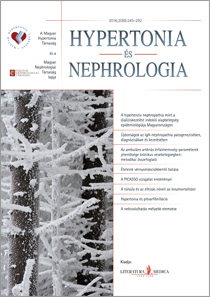The eLitMed.hu medical portal uses computer cookies for convenient operation. Detailed information can be found in the Cookie-policy.
Hypertension and nephrology - 2016;20(06)
Content
[New development in the pathogenesis, diagnosis and treatment of IgA nephropathy]
[IgA nephropathy is one of the leading cause of primary glomerulonephritis worldwide. IgA nephropathy is regarded as an immune mediated disease with a multi-hit pathogenesis starting with the production of poorly glycosylated IgA1 and glycan-specific IgG and IgA autoantibodies leading to the formation of IgA1 containing immune complexes. These immune complexes deposit in the glomerular mesangium followed by the onset of mesangioproliferative glomerulonephritis. The disease has variable clinical presentation and outcome. There is a need to identify patients who have the potential to progress to end-stage renal disease with the help of clinical, histological and biological markers. Treatment options for IgA nephropathy are largely based on opinion or weak evidence. It is true for the KDIGO Clinical Practice Guideline for Glomerulonephritis treatment recommendations containing low level of evidence for almost all recommendations related to IgA nephropathy. It is suggested to separate the patients into 3 groups on the basis of risk to progression and to give not-specific supportive treatment (especially angiotensin converting enzyme inhibitors or angiotensin receptor blocking agents) to all of them on the basis of the risk factors. We discuss the recommendations of the KDIGO Guideline about steroid and immunosuppressive treatment for moderate and high risk patients. Lastly, we provide our perspective on the existing other treatment options (tonsillectomy etc.) and on ongoing clinical trials.]
[Hypertension and atrial fibrillation]
[Hypertension is the most important independent risk factor of atrial fibrillation, the most common clinically significant arrhythmia. Increased atrial wall tension, myocardium remodelling, activation of renin-angiotensin-aldosterone system (RAAS) and fibrotic remodelling are possible hypertension induced mechanisms which can contribute to developing atrial fibrillation. Knowing the relation of hypertension to atrial fibrillation is crucial in the need for effective and up-to-date therapeutic strategies. RAAS inhibitors and beta blockers prevent atrial fibrillation not only by lowering blood pressure but partly due to the inhibition of the above mentioned mechanisms. Complications of hypertension, such as left ventricular hypertrophy and hypertensive cardiomyopathy are substantially limiting the number of drugs that can be used for rhythm control. In most cases in the presence of hypertension initiation of anticoagulation therapy is necessary too.]
[Deeper analysis of nebivolol effects]
[Author presents the formation of nitric oxide as a largest vasodilator of human endothelium as well as the endothelial dysfunction a result of formation at adrenergic stimulus. He demonstrates in detail the benefits of selective β-1 blocker and β-3 adrenergic agonist nebivolol in the vascular system. This drug has also receptor independent effects. Complex effects of nebivolol causes vasodilation, inhibits oxidative stress and it is capable to neutralize the effects of free oxygen radicals and as a result the endothelial function will be better. Its clinical effects and the less wellknown beneficial properties are listed. The use of drug is discussed especially in hypertensives with smoking, COPD or PAD. The β-3 agonist effect provides positive reactions not only in the adipocytes and the myocardial tissue. but in the skeletal muscle as well: Increase in energy expenditure - as a compensatory mechanism - is increased in obesity and the glucose uptake + storage on skeletal muscle cells are increased in hyperglycemia. The insulin sensitivity will be better, leptin level is decreased, adiponectin level is increased by nebivolol. It is assumed this drug has antidiabetic and anti-obesity effects.]
1.
Clinical Neuroscience
Is there any difference in mortality rates of atrial fibrillation detected before or after ischemic stroke?2.
Clinical Neuroscience
Factors influencing the level of stigma in Parkinson’s disease in western Turkey3.
Clinical Neuroscience
Neuropathic pain and mood disorders in earthquake survivors with peripheral nerve injuries4.
Journal of Nursing Theory and Practice
[Correlations of Sarcopenia, Frailty, Falls and Social Isolation – A Literature Review in the Light of Swedish Statistics]5.
Clinical Neuroscience
[Comparison of pain intensity measurements among patients with low-back pain]1.
Clinical Neuroscience Proceedings
[A Magyar Stroke Társaság XVIII. Kongresszusa és a Magyar Neuroszonológiai Társaság XV. Konferenciája. Absztraktfüzet]2.
3.
Journal of Nursing Theory and Practice
[A selection of the entries submitted to the literary contest "Honorable mission: the joys and challenges of our profession" ]4.
Journal of Nursing Theory and Practice
[End of Life and Palliative Care of Newborns in the Nursing Context]5.
Journal of Nursing Theory and Practice
[Aspects of Occupational Health Nursing for Incurable Patients ]


